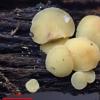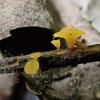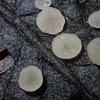
14-11-2025 16:26
 Marian Jagers
Marian Jagers
Hello everyone, On dead wood of Cytisus scoparius

14-11-2025 18:31
 Lothar Krieglsteiner
Lothar Krieglsteiner
Hello,can somebody provide me with a file of:Rothe

12-11-2025 09:25
 Viktorie Halasu
Viktorie Halasu
Hello, I need help with a pale terrestric Pseudom

11-11-2025 20:16
Bohan JiaHi, lastly I have found these tiny yellow decayin

09-11-2025 13:20
Hello.A tiny ascomycete, appearing as erupting gra

08-11-2025 00:29
 Francois Guay
Francois Guay
I found this species in Quebec, Canada, on herbace
 Hi,
Hi,I recently found these three Hymenoscyphus around Ottawa, ON, Canada, and I was unable to identify them by myself. I still have fresh material in a fridge if something needs to be rechecked.
If someone could help with all or some of them I will be very appreciative.
#1 Hymenoscyphus Cudoniella group?
On buried wood.
https://inaturalist.org/observations/80770446
#2
On rotten leaves (probably Acer).
https://inaturalist.org/observations/80526192
#3
On rotten leaves (probably Betula).
https://inaturalist.org/observations/80526469 A-inamyloid
https://inaturalist.org/observations/81606383 B-amyloid
Thank you for your help,
Igor


These H. kathiae and H. immutabilis are different. I've previously seen H. kathiae with larger spores and H. immutabilis IKI+ only.
I haven't seen true H. repandus, so I will need to do more reading.
Igor


Il n'y a pas du tout de couche gélatineuse autour des jeunes apothécies de ta récolte N°3 ?
Amitiés.Michel

Thank you Zotto, I understand that IKI reaction does not determine the species, but the presence of croziers does and I have croziers in #3 (H. immutabilis). I got strong IKI+b after KOH for #3, but I'm not certain that this is the right type, but maybe I shouldn't expect the same look of apical apparatus after KOH.
I uploaded pictures of #3 https://inaturalist.org/observations/80526469


I'm getting an amyloid reaction from the specimen from one leaf (with or without KOH).
And I retested the specimen from the first leaf, I'm getting only an inamyloid reaction (with and without KOH).
They all look the same to me, but I'm getting a different reaction. They are from different spots of the same forest.
Should I treat them as two different species?


I split them into two collections IKI+ and IKI-. I'm going to keep specimens if someone wants to study them in the future.


